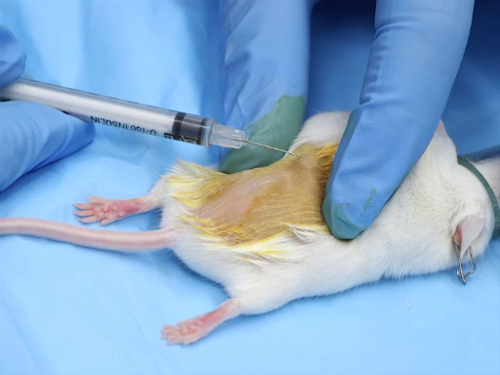Administración de compuestos III
Visión general
Fuente: Kay Stewart, RVT, RLATG, CMAR; Valerie A. Schroeder, RVT, RLATG. Universidad de Notre Dame, en
Hay muchas rutas utilizadas para la administración del compuesto en las ratas y ratones de laboratorio. Sin embargo, ciertos protocolos pueden requerir el uso de las rutas menos comunes, incluyendo inyecciones intradérmicas, intranasales e intracraneales. Formación especializada es esencial para estos procedimientos a realizarse con éxito. Justificación para estas rutas puede necesitar obtener la aprobación institucional cuidado Animal y el Comité uso (IACUC).
Procedimiento
1. intradérmica administración
- Más inyecciones intradérmicas son compuestos de base acuosa. Las soluciones deben ser fisiológicamente tamponadas para tener un pH neutro, para evitar necrosis de los tejidos en el sitio de inyección.
- El rango de tamaño de la aguja es de calibre 25-30, lo más pequeño posible.
- La gama de dosis por punto de inyección es que 50-100 μl. inyectables excesivos volúmenes pueden resultar en necrosis en el sitio de la inyección o fuga del compuesto fuera del sitio deb
Aplicación y resumen
La administración de compuestos en animales puede tener un efecto significativo tanto el bienestar de los animales y el resultado de los datos experimentales y valor científico. El método apropiado de suministro es esencial para el éxito del experimento. Muchos factores deben ser considerados para determinar la mejor ruta, incluyendo el objetivo científico del estudio, el pH de la sustancia, el volumen de la dosificación requerida, la viscosidad de la sustancia y el bienestar de los animales. Conocimientos técnico...
Referencias
- Turner, P.V., Pekow, C., Vasbinder, M. A., and Brabb, T. 2011. Administration of substances to laboratory animals: equipment and considerations, vehicle selection, and solution preparation. JAALAS. 50: 614-627.
- Dhuria, S.V., Hanson, L.R., and Frey II, W.H. 2010. Intranasal delivery to the central nervous system: mechanisms and experimental considerations. Journal of Pharmaceutical Sciences. 99: 1654-1673.
- Stevens, J., Suidgeest, E, Van der Graaf, P.H., Danhof, M., and De Lange, E.C. 2008. Development and evaluation of a new, minimal-stress animal model for intranasal administration in freely moving rats. Poster presentation at American Association of Pharmaceutical Scientists Annual Meeting, Atlanta, Georgia.
- Morton, D.A., Jennings, M., Buckwell, A., Ewbank, R., Godfrey, C., Holgate, B., Inglis, I., James, R., Page, C., Sharman, I., Verschoyle, R., Westall, L., and Wilson, A.B. 2001. Refining procedures for the administration of substances Report of the BVAAWF/FRAME/RSPCA/UFAW Joint Working Group on Refinement. Members of the Joint Working Group on Refinement. Laboratory Animals. 35: 1-41.
Tags
Saltar a...
Vídeos de esta colección:

Now Playing
Administración de compuestos III
Lab Animal Research
31.5K Vistas

Técnicas de manipulación y sujeción de roedores
Lab Animal Research
175.0K Vistas

Procedimientos de atención básica
Lab Animal Research
28.0K Vistas

Fundamentos de la crianza y destete
Lab Animal Research
35.8K Vistas

Identificación de roedores I
Lab Animal Research
54.9K Vistas

Identificación de roedores II
Lab Animal Research
25.7K Vistas

Administración de compuestos I
Lab Animal Research
100.9K Vistas

Administración de compuestos II
Lab Animal Research
35.0K Vistas

Administración de compuestos IV
Lab Animal Research
51.8K Vistas

Extracción de sangre I
Lab Animal Research
172.1K Vistas

Extracción de sangre II
Lab Animal Research
73.5K Vistas

Mantenimiento e inducción de la anestesia
Lab Animal Research
50.8K Vistas

Consideraciones para la cirugía de roedores
Lab Animal Research
22.5K Vistas

Necropsia diagnóstica y recolección de tejidos
Lab Animal Research
58.2K Vistas

Recolección de tejidos estériles
Lab Animal Research
34.9K Vistas
ACERCA DE JoVE
Copyright © 2025 MyJoVE Corporation. Todos los derechos reservados



